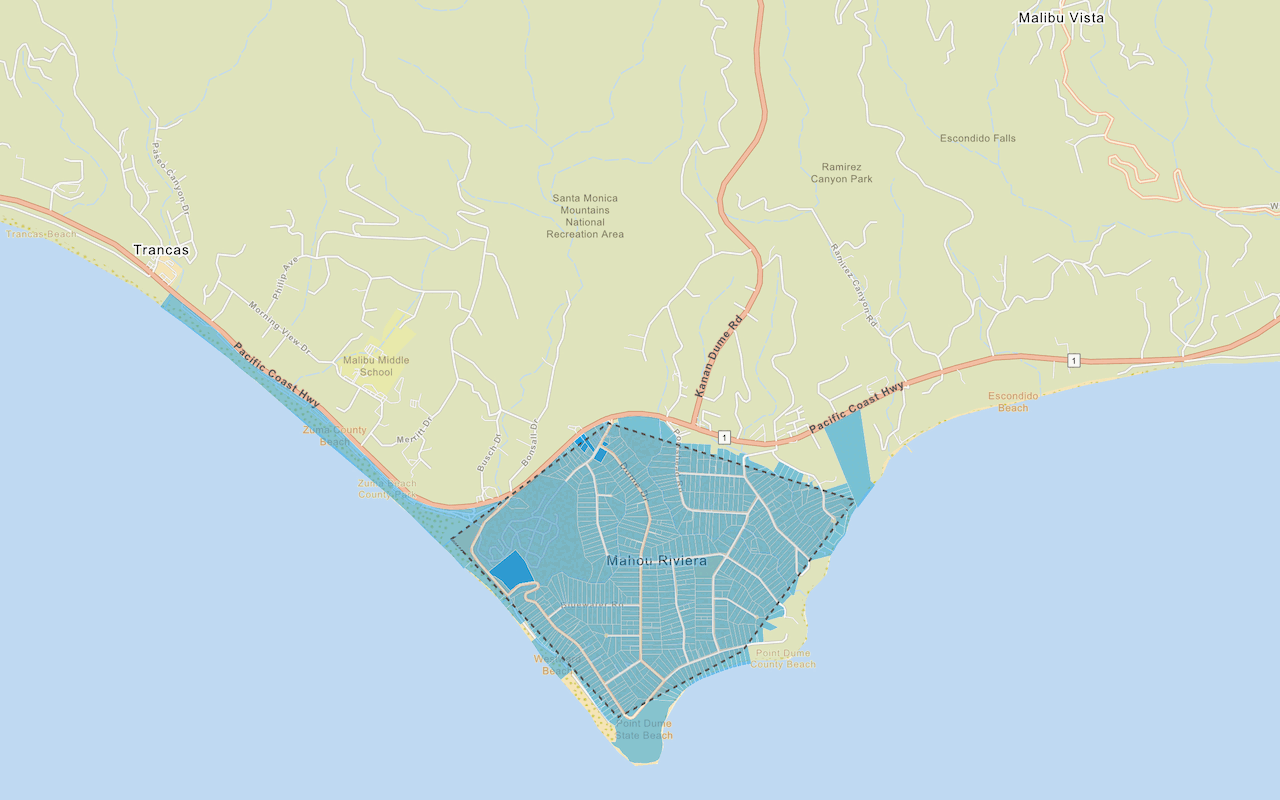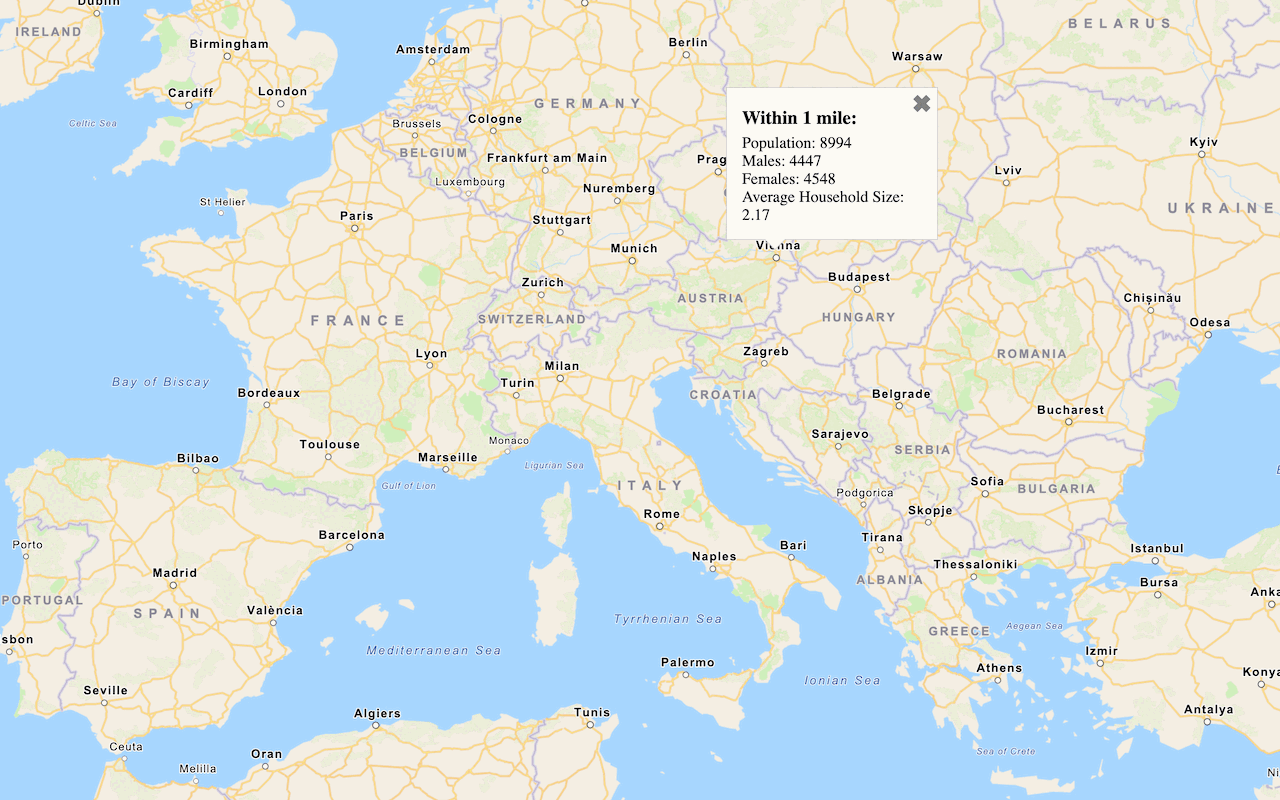Learn how to display feature attributes in a pop-up.
A pop-up, also known as a "popup", is a visual element that displays information about a feature when it is clicked. You typically style and configure a pop-up using HTML and CSS for each layer in a map. Pop-ups can display attribute values, calculated values, or rich content such as images, charts, or videos.
In this tutorial, you create an interactive pop-up for the Trailheads feature layer in the Santa Monica Mountains. When a feature is clicked, a pop-up is displayed containing the name of the trail and the service that manages it. You use the ol-popup library to achieve this.
Prerequisites
An ArcGIS Location Platform or ArcGIS Online account.
Steps
Get the starter app
Select a type of authentication below and follow the steps to create a new application.
Set up authentication
Create developer credentials in your portal for the type of authentication you selected.
Set developer credentials
Use the API key or OAuth developer credentials so your application can access location services.
Add the pop-up library
OpenLayers does not include a pop-up component. You can use the third-party library ol-popup to simplify adding pop-ups to your map.
-
In the
<headelement, add references to the ol-popup library.> Use dark colors for code blocks <link rel="stylesheet" href="https://cdn.jsdelivr.net/npm/ol@v10.4.0/ol.css" type="text/css" /> <script src="https://cdn.jsdelivr.net/npm/ol@v10.4.0/dist/ol.js"></script> <script src="https://cdn.jsdelivr.net/npm/ol-mapbox-style@12.3.5/dist/olms.js" type="text/javascript"></script> <script src="https://unpkg.com/ol-popup@5.1.1/dist/ol-popup.js"></script> <link rel="stylesheet" href="https://unpkg.com/ol-popup@5.1.1/src/ol-popup.css" />
Add the trailheads layer
Use a Vector layer with a Vector source to display the trailheads as GeoJSON.
For more information about adding feature layers using GeoJSON, see the Add a feature layer as GeoJSON tutorial.
-
Before the
olmsinitialization, create a aVectorlayer. Give it aVectorsource with a GeoJSON feature format to load and display the trailheads feature layer. Save it to atrailheadsvariable.Layer Use dark colors for code blocks const basemapId = "arcgis/outdoor"; const trailheadsLayer = new ol.layer.Vector({ source: new ol.source.Vector({ format: new ol.format.GeoJSON(), url: `https://services3.arcgis.com/GVgbJbqm8hXASVYi/arcgis/rest/services/Trailheads/FeatureServer/0/query?where=1%3D1&outFields=*&returnGeometry=true&f=pgeojson`, }) }); -
Add the data attribution for the vector tile layer source.
- Go to the Trailheads (Santa Monica Mountains) item.
- Scroll down to the Credits (Attribution) section and copy its value.
- Create an
attributionproperty and paste the attribution value from the item.Use dark colors for code blocks const basemapId = "arcgis/outdoor"; const trailheadsLayer = new ol.layer.Vector({ source: new ol.source.Vector({ format: new ol.format.GeoJSON(), url: `https://services3.arcgis.com/GVgbJbqm8hXASVYi/arcgis/rest/services/Trailheads/FeatureServer/0/query?where=1%3D1&outFields=*&returnGeometry=true&f=pgeojson`, // Attribution text retrieved from https://arcgis.com/home/item.html?id=883cedb8c9fe4524b64d47666ed234a7 attributions: ['| Los Angeles GeoHub'] }) });
-
Inside
olmsload handler, usemap.addto add this layer to the map.Layer Use dark colors for code blocks olms.apply(map, `https://basemapstyles-api.arcgis.com/arcgis/rest/services/styles/v2/styles/${basemapId}?token=${accessToken}`).then(function (map) { map.addLayer(trailheadsLayer); // Add Esri attribution // Learn more in https://esriurl.com/attribution const source = map.getLayers().item(0).getSource(); source.setAttributions("Powered by <a href='https://www.esri.com/en-us/home' target='_blank'>Esri</a> | ") });
Initialize the pop-up
A Popup is a type of Overlay. Use map.add to add it to the map.
-
Create a new
Popupand save it to apopupvariable. Add it to the map withmap.add.Overlay Use dark colors for code blocks map.addLayer(trailheadsLayer); // Add Esri attribution // Learn more in https://esriurl.com/attribution const source = map.getLayers().item(0).getSource(); source.setAttributions("Powered by <a href='https://www.esri.com/en-us/home' target='_blank'>Esri</a> | ") }); const popup = new Popup(); map.addOverlay(popup);
Display a pop-up on click
A pop-up can display any HTML content. Use a click event handler to detect the click, then use map.get to find any trailhead features at the clicked point. You pass a function as a layer to do so.
If the returned array contains at least one feature, you can use Feature.get to extract the trail name (TRL) and park name (PARK). You then use popup.show to update the pop-up position and content.
-
Add a
clickevent handler. Inside, usegetto get an array of trailhead features clicked on.Features At Pixel Use dark colors for code blocks const popup = new Popup(); map.addOverlay(popup); map.on("click", (event) => { let trailName, parkName; const trailheads = map.getFeaturesAtPixel(event.pixel, { layerFilter: (layer) => layer === trailheadsLayer }); }); -
If there is a trail name to show, use
popup.showto set the position and content of the pop-up. Otherwise, usepopup.hideto hide it.Use dark colors for code blocks const trailheads = map.getFeaturesAtPixel(event.pixel, { layerFilter: (layer) => layer === trailheadsLayer }); if (trailheads.length > 0) { const trailName = trailheads[0].get("TRL_NAME"); const parkName = trailheads[0].get("PARK_NAME"); popup.show(event.coordinate, `<b>${trailName}</b></br>${parkName}`); } else { popup.hide(); }
Run the app
Run the app.
The map view should display the Trailheads feature layer. When you click a feature, the name of the trailhead and its park name is displayed in a pop-up.What's next?
Learn how to use additional ArcGIS location services in these tutorials:

Query a feature layer (spatial)
Execute a spatial query to access polygon features from a feature service.

Get global data
Query demographic information for locations around the world with the GeoEnrichment service.

Get local data
Query regional facts, spending trends, and psychographics with the GeoEnrichment service.

Add a feature layer
Add features from feature layers to a map.